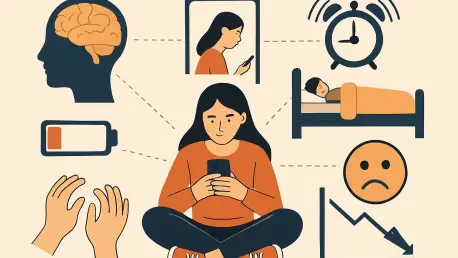In an era where smartphones are woven into the fabric of daily life, their constant presence has transformed from a mere convenience into a potential source of disruption for countless individuals across the globe, impacting their ability to maintain balance. For many, what begins as a tool for communication and productivity spirals into an addiction that undermines work, strains relationships, and erodes mental well-being. This pressing societal challenge is the focus of a groundbreaking study that employs network analysis to dissect the intricate web of symptoms and factors fueling mobile phone overuse. Unlike conventional research that often seeks a singular cause, this approach frames addiction as a dynamic system of interconnected behaviors, emotions, and personal traits. By mapping these connections, the study identifies pivotal drivers of addiction and uncovers distinct patterns between genders, shedding light on tailored paths to intervention. As smartphones continue to dominate modern existence, understanding and addressing this pervasive issue has never been more urgent. The insights gained from this innovative methodology not only deepen comprehension of mobile phone addiction but also pave the way for more effective strategies to mitigate its impact on individuals and society at large.
Decoding the Nature of Smartphone Dependency
The phenomenon of mobile phone addiction extends far beyond excessive screen time; it represents a complex behavioral pattern characterized by distinct symptoms that profoundly affect daily functioning. Key indicators include withdrawal, where individuals feel anxious or incomplete without their device, and salience, where phone use takes precedence over critical responsibilities like work or family. Impulsivity often compounds the issue, as the urge to check notifications or scroll through apps becomes nearly irresistible. These symptoms collectively create a cycle of dependency that disrupts social interactions and personal goals, highlighting the depth of the challenge at hand. Recognizing addiction as more than a simple habit is essential to grasping its pervasive influence on modern life.
This behavioral issue cannot be attributed to a single trigger but rather emerges from a multifaceted interplay of personal characteristics, emotional states, and cognitive tendencies. Traditional models that point to one root cause fall short in capturing this complexity, as they overlook how various elements reinforce each other in a continuous loop. For instance, emotional distress might prompt excessive phone use as a coping mechanism, which in turn deepens reliance on the device for comfort. This systemic perspective shifts the focus from isolated fixes to a broader understanding of how addiction forms and persists. It also explains why superficial solutions often fail, as addressing one aspect leaves the underlying network of influences largely untouched.
A Revolutionary Approach Through Network Analysis
Network analysis emerges as a transformative tool in studying mobile phone addiction, offering a fresh perspective that departs from conventional research methods. By representing symptoms and contributing factors as nodes within a network, and their relationships as connecting lines or edges, this method visualizes the intricate dynamics at play. It reveals which elements hold the most influence, often termed central nodes, that drive the addiction cycle with significant impact. For example, the distress of being without a phone might closely link to seeking social comfort through digital means, forming a self-reinforcing pattern. This approach captures the reciprocal nature of addiction, providing a comprehensive view of how various factors interact over time.
The strength of network analysis lies in its ability to pinpoint where interventions can yield the greatest effect by focusing on these central nodes rather than peripheral issues. Unlike older studies that might aggregate data into broad scores, this method dissects specific connections, showing how one symptom can amplify others across the system. Its application aligns with emerging trends in psychological research, where similar techniques are used to explore conditions like anxiety or depression, emphasizing interconnectedness over isolation. By offering a clearer picture of addiction as a cohesive network, this innovative framework not only enhances understanding but also sets a foundation for more strategic and impactful solutions to curb smartphone overuse.
Core Symptoms Fueling the Addiction Cycle
At the heart of mobile phone addiction lie several core symptoms that act as primary drivers within the network of behaviors and emotions. Withdrawal stands out as a potent force, manifesting as unease or a sense of loss when separated from the device, often pushing individuals back to their screens for relief. Salience further intensifies the problem, as the phone becomes a dominant focus, overshadowing essential tasks and personal connections. These symptoms are not mere inconveniences; they reshape how individuals prioritize their time and energy, often at the expense of real-world engagements. Their prominence in the addiction network underscores the challenge of breaking free from such ingrained patterns.
Impulsivity and social comfort also play critical roles in sustaining mobile phone addiction, each contributing uniquely to the cycle. Impulsivity, characterized by an almost automatic reach for the phone, entrenches the habit by bypassing conscious control, making resistance a constant struggle. Meanwhile, social comfort—relying on the device to feel connected or confident in interactions—often intertwines with withdrawal, creating an emotional dependency that fuels further use. The interconnectedness of these symptoms means that a ripple effect can occur, where one issue exacerbates others, deepening the overall impact. Mapping these relationships provides vital clues about why certain individuals find it harder to regain balance in their digital habits.
Protective Mechanisms to Counteract Overuse
Amid the factors that drive mobile phone addiction, certain elements serve as vital protective mechanisms, helping individuals resist the pull of overuse. Psychological resilience emerges as a cornerstone in this regard, particularly the capacity to recover from setbacks without turning to digital escapes. Those with high resilience are better equipped to handle stress or disappointment, reducing the likelihood of seeking solace in endless scrolling or notifications. This trait acts as a buffer, weakening the links between emotional triggers and compulsive phone use, and offers a promising avenue for building healthier habits in a tech-saturated world.
Other protective factors, such as a future-oriented mindset and effective emotion regulation, also play significant roles in curbing dependency. A focus on long-term goals over immediate gratification helps individuals prioritize meaningful activities over fleeting digital distractions, creating a natural deterrent to overuse. Similarly, the ability to manage emotions constructively—without relying on a smartphone for relief—disrupts the cycle of stress-driven behavior that often leads to addiction. Adaptive cognitive strategies, like reframing challenges in a positive light, further support this resistance by fostering a mindset less prone to escapism. Strengthening these protective elements could prove instrumental in helping people regain control, offering a counterbalance to the pervasive allure of constant connectivity.
Risk Elements That Intensify Dependency
Contrasting with protective factors, several risk elements act as catalysts in the mobile phone addiction network, heightening vulnerability to overuse. A pronounced need for uniqueness often drives individuals to seek validation through social media, where likes and comments become a measure of self-worth, perpetuating compulsive phone checking. This desire to stand out can create a feedback loop, as the quest for digital affirmation overrides other priorities, embedding the habit deeper into daily routines. Such risk factors highlight the subtle yet powerful ways personal traits can exacerbate dependency in a hyper-connected environment.
Mind wandering and negative thought patterns further fuel the addiction cycle by creating mental spaces that smartphones easily occupy. When focus drifts, the device often becomes a default distraction, filling attentional gaps with mindless browsing that reinforces impulsivity. Additionally, tendencies to magnify problems or dwell on negatives can heighten stress, prompting individuals to turn to their phones as a quick escape, only to find temporary relief that masks deeper issues. These risk elements are tightly woven into the addiction network, amplifying symptoms like withdrawal or salience. Identifying and addressing them is crucial for prevention efforts, as they reveal specific vulnerabilities that can be targeted to halt the spiral of dependency before it escalates.
Gender-Specific Patterns in Smartphone Use
A compelling revelation from the study is the distinct ways mobile phone addiction manifests across genders, reflecting unique emotional and behavioral drivers. Women often report higher levels of addiction, with a particular emphasis on emotional reliance, where the absence of their phone triggers feelings of loneliness or disconnection. This tie to social comfort through digital platforms suggests that for many women, the device serves as a primary means of maintaining relationships, intensifying the struggle to reduce usage. Such patterns point to the importance of understanding underlying needs that shape how addiction takes hold in different demographic groups.
Men, on the other hand, exhibit stronger interconnections among addiction symptoms, indicating a more tightly knit cycle of self-reinforcing behaviors. Distraction during critical tasks, such as work or academic pursuits, frequently emerges as a central issue for men, underscoring a behavioral challenge in maintaining focus amid digital temptations. These gender-specific differences extend to the influence of protective and risk factors, with varying cognitive and emotional strategies playing prominent roles in each group. Recognizing these divergent pathways is essential for crafting interventions that resonate with the specific experiences of men and women, ensuring that solutions are not only relevant but also effective in addressing the nuances of addiction.
Designing Targeted Solutions for Recovery
The insights gleaned from network analysis pave the way for innovative, targeted interventions that address the root dynamics of mobile phone addiction. For men, strategies might center on minimizing distractions in structured environments like workplaces or classrooms, employing practical tools such as app blockers or designated phone-free periods to reinforce focus. Enhancing psychological resilience through training programs that emphasize stress management and goal-setting could further disrupt the addiction cycle, providing men with the skills to navigate challenges without digital crutches. These tailored approaches aim to weaken the behavioral drivers that often dominate male addiction networks, fostering sustainable change.
For women, interventions could prioritize alleviating emotional dependence on smartphones by encouraging alternative avenues for social connection, such as in-person interactions or community activities that fulfill the need for belonging. Addressing negative thought patterns that amplify stress—through techniques like cognitive restructuring or mindfulness—also holds promise in reducing the urge to seek relief through phone use. The broader implication of this research is a call for personalized solutions that respect individual and gender-based differences within addiction networks. By focusing on central elements identified through network analysis, these strategies aim to create ripple effects that dismantle the system of dependency, offering a path toward healthier digital engagement.
Reflecting on Paths Forward
Looking back, the exploration of mobile phone addiction through network analysis marked a significant shift in how this pervasive issue was understood and approached. The identification of core symptoms, protective and risk factors, and gender-specific patterns provided a nuanced framework that moved beyond simplistic explanations of overuse. This systemic perspective illuminated the intricate connections that sustained addiction, revealing why past efforts often fell short when they targeted isolated aspects rather than the network as a whole. The adoption of innovative methodologies like network analysis proved instrumental in mapping these dynamics, offering clarity on where interventions could strike with maximum impact.
As a next step, future efforts should build on these findings by developing and testing gender-tailored programs that address the unique drivers of addiction for men and women. Collaboration between tech companies, mental health professionals, and policymakers could foster environments that promote balanced smartphone use, such as through built-in usage limits or public awareness campaigns. Additionally, expanding research to diverse populations will ensure that solutions remain inclusive and adaptable to varying cultural and social contexts. By continuing to refine these targeted strategies, society can better equip individuals to navigate the digital landscape with control and intention, transforming smartphones from sources of dependency into tools of empowerment.









